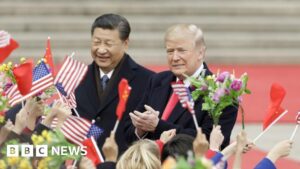Victorian government to rezone affluent areas in bid to attract ‘locked out’ young people to 50 suburbs | Victoria
The Victorian Labor government is set to seize planning control of some of Melbourne’s most affluent suburbs in an effort to build thousands more homes, setting the stage for a fight with the opposition and local government.
The premier, Jacinta Allan, will announce an overhaul of planning rules in 50 inner-Melbourne areas located near public transport, including in Brighton, Malvern and Toorak, to allow for greater density.
She will argue young people are now “locked out” of these areas – despite being close to jobs, transport and services – due to low availability and high property prices.
Twenty-five of the 50 new “activity centres” to be unveiled on Sunday include Armadale, Hawksburn, Malvern and Toorak stations on the Frankston railway line, Auburn, Hawthorn and Glenferrie on the Belgrave-Lilydale line and North Brighton, Middle Brighton, Hampton and Sandringham on the Sandringham line.
The planning takeover will clear the way for “taller buildings” of between 10 and 20 storeys near the stations and “gentle, scaled height limits and more low-rise apartments and townhouses” of between three and six storeys alongside exisiting homes in the “walkable catchments” surrounding them.
The government said in these catchments, which will be up to 800 metres from the stations, the rights of residents to appeal development “will not change and heritage and landscape overlays will stay in place”.
However, residents could lose the power to appeal developments closer to stations.
The remaining 25 locations will be announced in late 2024, alongside the release of Plan Victoria, the government’s growth strategy for the state. The consultation process for all 50 new centres is likely to be completed by 2026, the government said.
KPMG urban economist Terry Rawnsley last month released a report that showed despite the Victoria’s growing population, some inner Melbourne suburbs had experienced a mass exodus of young people due to lack of affordable housing.
He said these young people were likely to move to outer areas of Melbourne, putting increased strain on transport and local infrastructure.
“These suburbs [named by the government] are some of the best served in the state when it comes to infrastructure – whether it’s transport, schools, open space, hospitals, access to jobs,” Rawnsley said.
“Getting more people living in there means we don’t have to build new schools and other infrastructure in the western greenfields.”
“Local residents might be concerned about change, but we live in a city, not a museum. If you think about places like Box Hill, Brunswick or South Yarra, they’ve kind of all gone through this transition over the last 30 years but still retain that suburban feel once you get away from the main activity.”
It follows a similar move in New South Wales, where the government has rezoned land around train stations.
The move will probably be met with support by groups such as the Property Council and Yimby Melbourne, which has argued amenity-rich suburbs must shoulder the burden of new housing. But it will face fierce opposition from councils, who have been critical of the government’s 10 existing activity centres, where 60,000 new homes are expected to be built by 2051.
They are located in Broadmeadows, Camberwell Junction, Chadstone, Essendon North, Epping, Frankston, Moorabbin, Niddrie, Preston and Ringwood.
after newsletter promotion
In recent weeks, the state opposition has held a series of meetings with residents living near the 10 centres and vowed to oppose “any attempt to remove third-party rights in the planning process and any attempt by Labor to remove heritage protections”.
Of the 25 new activity centres, 14 are located within Liberal MPs’ seats, including three in the Hawthorn electorate of opposition leader, John Pesutto, three in the seat of Brighton, held by the shadow planning spokesperson, James Newbury, and seven in Michael O’Brien’s seat of Malvern.
Just seven are located in seats held by Labor MPs: Middle Footscray, West Footscray and Tottenham stations in Footscray, and Carnegie, Hughesdale, Murrumbeena and Oakleigh in the inner-east.
Three new activity centres are in the seat of Ringwood, held by expelled Labor MP turned crossbencher Will Fowles, and one is in the seat of Prahran, held by Greens MP Sam Hibbins.
Privately, several Labor MPs have told Guardian Australia they are “itching for a fight” against the Coalition on housing, as they believe it will help court not only millennial and gen Z voters – who now outnumber baby boomers on the electoral roll – but also their concerned parents.
“The Libs won’t be able to help themselves, they’ll behave like nimbys and oppose it all,” one Labor MP said.
In a statement on Sunday, the premier said her plan would give more young people the “opportunity to rent or buy a place that’s directly connected to public transport”.
“I know it won’t fix everything, but it will deliver more homes and new life to inner suburbs that are full of jobs, transport and services – where young buyers and renters are currently locked out,” Allan said.
The planning minister, Sonya Kilkenny, said changes would not occur overnight.
“This is about incremental change that sets Victoria up for the next generation, so we can have more opportunities for young people and better communities for everyone,” she said.
#Victorian #government #rezone #affluent #areas #bid #attract #locked #young #people #suburbs #Victoria
News plays a pivotal role in our lives by keeping us informed and connected to the world. It serves as a critical source of information, offering updates on current events, politics, economics, science, and more. Through news, we gain awareness of global issues and local developments, helping us make informed decisions in our personal and professional lives. News also fosters discussion and debate, encouraging critical thinking and perspective-taking. Moreover, it promotes transparency and accountability among governments, businesses, and other institutions. In a rapidly changing world, staying updated with the news enables us to adapt to new challenges and opportunities, shaping our understanding of the complexities of society. Ultimately, news is not just about information; it empowers us to participate actively in the world around us, contributing to a more informed, engaged, and responsible global citizenry.
Health is fundamental to our well-being and quality of life, making it an essential aspect of daily existence. It encompasses physical, mental, and emotional aspects, influencing our ability to function effectively and enjoy life fully. Prioritizing health allows individuals to maintain optimal physical fitness, reducing the risk of diseases and promoting longevity. Mental health, equally crucial, affects our cognitive abilities, emotional stability, and overall happiness. Investing in preventive healthcare through exercise, balanced nutrition, and regular medical check-ups helps in early detection of potential health issues, ensuring timely intervention and treatment. Beyond individual benefits, a population’s health impacts societal productivity and economic stability. Governments and organizations worldwide emphasize public health initiatives to address pandemics, health disparities, and promote overall well-being. Ultimately, health serves as the foundation upon which we build our lives, influencing our ability to pursue goals, nurture relationships, and contribute meaningfully to society.
Money plays a crucial role in our lives as a means of financial security and freedom. It enables us to meet basic needs such as food, shelter, and healthcare, while also providing opportunities for education, travel, and personal growth. Beyond material comforts, money facilitates social connections and experiences that enrich our lives. It empowers individuals to invest in their futures, whether through savings, investments, or entrepreneurial ventures, thereby fostering economic stability and growth. However, the pursuit of wealth should also be balanced with ethical considerations, as money can influence relationships and societal dynamics. Responsible management of finances is key to achieving long-term goals and mitigating financial stress. Ultimately, while money is a tool for achieving aspirations and fulfilling desires, its true value lies in how it is utilized to improve both personal well-being and the broader community.
Earning Easy Money in 2024: Opportunities and Considerations 💸
In 2024, the landscape of earning easy money presents diverse opportunities, albeit with considerations. The digital age offers platforms for freelancing, online trading, and e-commerce, allowing individuals to leverage skills and creativity for financial gain. Cryptocurrency investments continue to allure with potential for quick profits, yet they entail high volatility and risk. Moreover, the rise of the gig economy enables flexible work arrangements through apps and websites, offering quick payouts but often without job security or benefits. Passive income streams such as rental properties and investments in stocks or bonds remain viable, but demand initial capital and ongoing management. Amid these options, caution is essential to avoid scams and unsustainable ventures promising overnight success. Ultimately, while the allure of easy money persists, informed decisions, diligence, and a long-term perspective are crucial for sustainable financial growth and security in the dynamic year ahead.





